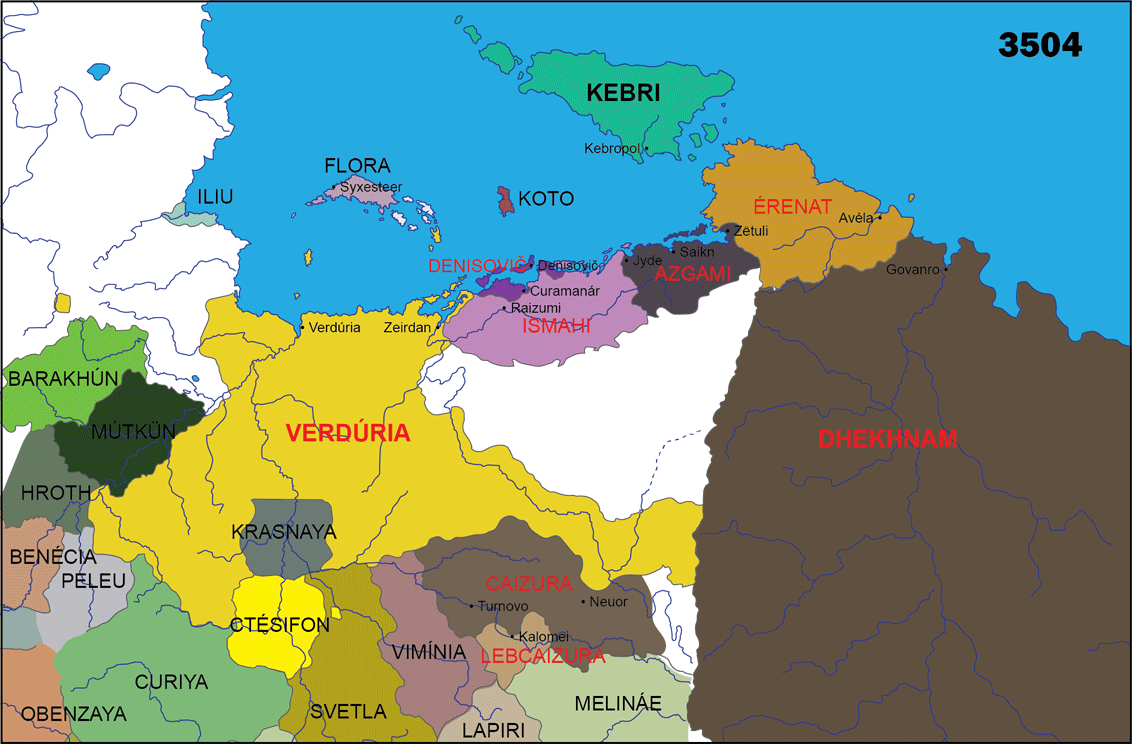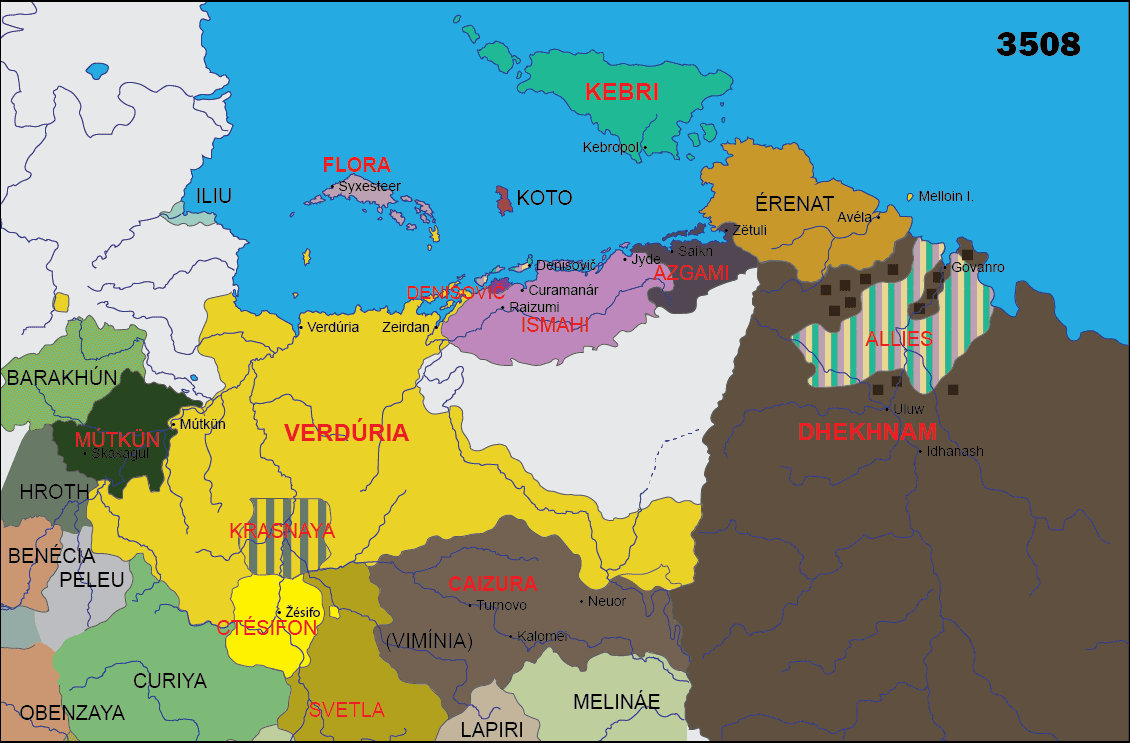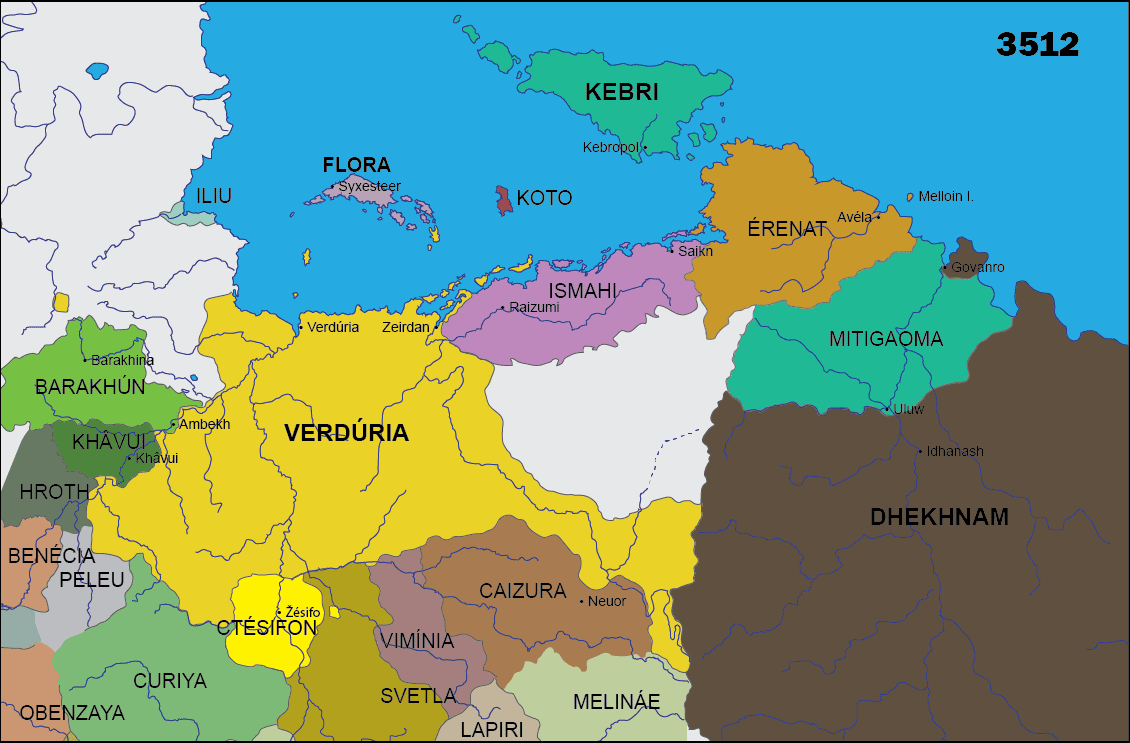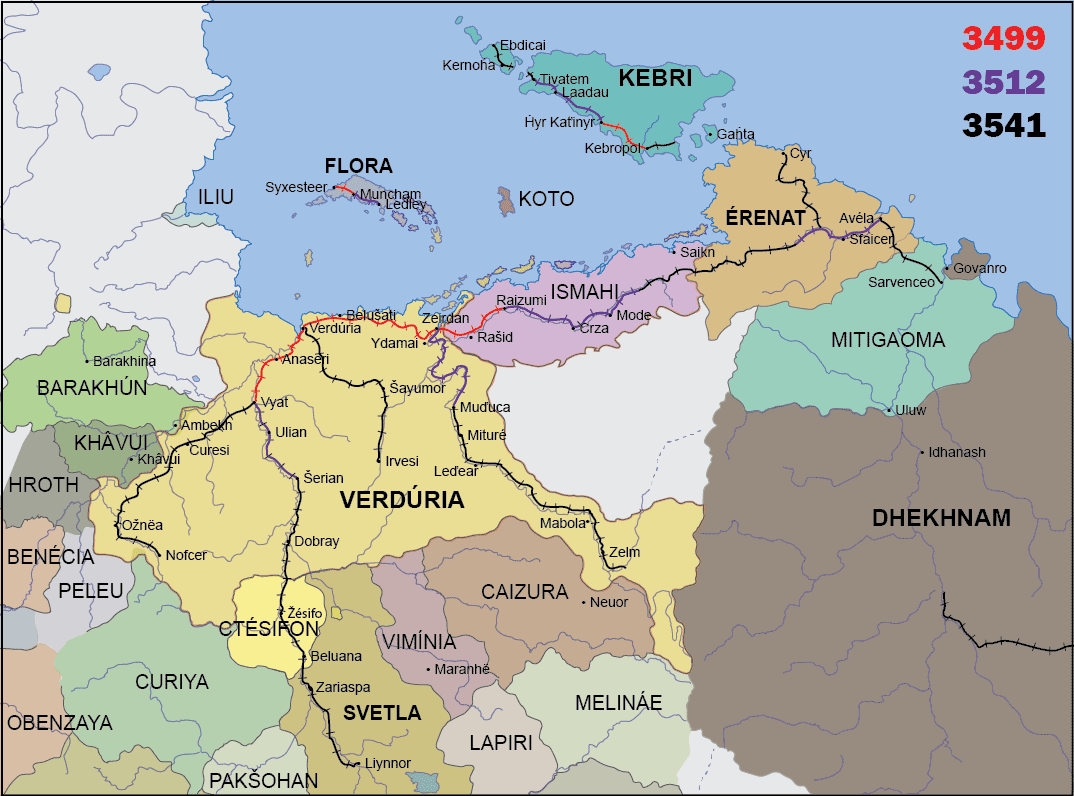The First Dhekhnami War

This is part of my Almea+400 project, which details the history of Almea for four centuries past 3480— through the industrial age, the modern age, and well into science-fiction territory. On Patreon I’ve made almost a hundred posts in the last year and a half, and we’re about to start the second Dhekhnami war. I invite you to come join the fun!
The main history will also be available in (at least) two books, of the same size and format as the Historical Atlas of Almea. This is a preview of both projects.
Some background for this page: Kebri and Verduria fought a war in 3492-3, in Nan; this is important because both sides developed breech-loading rifles.
The Verdurian prime minister, Abend Monteneon (right), saw war with Dhekhnam upcoming; as preparation he pushed for the creation of a railroad from Verduria-city to Raizumi, at whatever cost. (The first railroad had been built in 3485.)
Svetla and Ctésifon fought a war in 3497–99; some of the small states in the south of Eretald were absorbed by one side or the other. Abend was out of office for the start of the war, but was reinstated when the Caďin leader Žuliosu surcont Curesi dithered too much on which side to support. Abend pressured both sides to make peace, so he could concentrate on the north.
King Alric died in 3496, aged 73; his daughter Tilye became queen.
—Mark Rosenfelder, Jan. 2021
War in Ismahi

Denisovič (or Dênesvişe) was a strange remnant of the Eleďe dynasty’s wars with Kebri. Verduria had conquered most of the Ismaîn littoral in 3284, but keeping it was not acceptable to Kebri (or to Ismahi, to the extent that its opinion mattered). Instead Verduria annexed the nearer portions, and made the rest more or less independent. It was a confederacy with barely any nationwide government, and for two centuries it was almost entirely bypassed by modern development.
In 3487 there was a drive to modernize the government, led by the burghers of Denisovič city as well as Humegł surcont Curamanár, the leading noble, and also the dominant figure in the tiny nation’s other large city. Humegł became president of the reformed government. The reforms mostly consisted of liberalizing trade policies and establishing a university. The Verdurian ambassador was removed from the Hôsicŕe (Council); Verduria supported this, as the position was seen as an embarrassing anachronism.
Denisovič prospered after its reform, building factories and even its own little fleet. Humegł’s power seemed to continually increase, but he was popular.
In late 3498 Humegł announced that Denisovič would become part of Azgami. It was soon realized that there were already Azgamian troops in Denisovič, and that much of its new prosperity had been financed by Dhekhnam.
Tension between Azgami and Ismahi had been increasing for a decade, and Ismahi felt that this latest provocation, which would leave it with enemy territory on two sides, was unacceptable. King Azegome 3e, supported by a unanimous Elŕynes Hôsicŕe (King’s Council), declared war in early 3499.
Naturally, he had Abend’s support. By this time the Mišicama Railway ran from Verduria-city to Raizumi, and he and Azegome agreed to extend it as far east as possible.
He also had the support of Kano Nëroniháno, president of Érenat and leader of the Fako Imrafë (Progressive Party). The allies sent troops to reinforce the Ismaîn— though not in great numbers at first, hoping to defeat the Azgamians before Dhekhnam intervened directly.
This was the first major war in Eretald in centuries, and military technology developed quickly. The Ismaîn were proud of their well-trained and vigorous cavalry; they found that it was mowed down by rifle fire and the latest generation of cannons. Steel-clad steamships bombarded the cities and each other. Abend was able to move large numbers of troops east by railway.
Both sides soon discovered that modern firepower favors the defense. In previous wars— waged with sword, bow, and horse— an aggressive charge often won the battle, scattering the defenders. Advancing into a hail of lead was a different proposition. An attacker often needed twice the strength of the defenders to prevail, and even then was unable to prevent the defenders from retreating in good order. The result was that the war was waged fiercely but inconclusively. Ismahi was able to push through to the sea just east of Curamanár, but after that the front barely moved. When it threatened to do so, the allies or Dhekhnam would throw in more resources.
This was also the first war of the newspaper age. Journalists traveled to the front and, for the first time, sent daily dispatches back home of how the battle was raging, and more importantly, of the hellish conditions the hometown soldiers were facing. If anything Abend encouraged this: he knew that Verduria above all wanted to expand its mercantile empire in peace, and that it would take a major cultural change for it to evolve into a state capable of confronting Dhekhnam. The battlefield dispatches went down much more badly in Avéla.
Crisis in Érenat
Things became worse in reli 3503, when Dhekhnam engineered a “rebellion” in western Érenat, around Zëtuli. It poured in Dhekhnami troops, so that Érenat found itself fighting on its own soil. Incidents proliferated on the eastern border, where it faced the colossus directly.
The country increasingly wondered what it had to gain fighting with its immense neighbor; and many felt, possibly accurately, that more Érenatis than Verdurians were fighting. In calo 3503, Namašo cont Cyr, leader of the opposition Pironáe [Fatherland] party, quit the unity government that had been established early in the war, and won the succeeding elections.
Cyr’s new government discreetly inquired what would end the war. All that was required was to end the war with Azgami and exit the alliance with Verduria. The Érenatis agreed, withdrawing their forces from Azgami and telling the Verdurians to leave Melloin Island. They awaited the rebels dispersing, which kept being put off.
War in the south
Meanwhile, in cuéndimar, a pro-Dhekhnami faction took over in Caizura. Almost immediately, with Dhekhnami help, it overran the northern half of Lebcaizura, isolating the Lebcaizurans from the north of Eretald.
This was an immense escalation of the war, directly threatening the Eretaldan heartland, and as such was a propaganda boost for Abend. The Caďin party, which had halfheartedly supported the war under Curesi’s successor Fálefar Lekaro, demanded action, and accepted Abend’s proposal for a unity government.
As he repeatedly declared, “I will not be the Sevurias of the 36th century.” He believed that Verduria was not ready for a major war— but that inaction would only strengthen Dhekhnam. With Lekaro’s support, as well as some timely admonitions from Queen Tilye, he was able to take the first major step: passing a law requiring universal conscription.
This would take time to bear fruit, but as fast as divisions were raised, Abend sent them east into Ismahi. This soon stabilized the eastern front, which had wavered dangerously when the Érenatis withdrew. The Verdurians also worked furiously on extending the Mišicama Railway eastward. Nonetheless, the only major victory to report in 3503 was the capture of Curamanár in želea. (Humegł escaped and holed up in the city of Denisovič.)
It was more difficult to support Lebcaizura, especially as Vimínia refused to allow the troops passage. He sent a division south from Zelm to impede the Caizurans’ communications with Dhekhnam.
Planning a countermove
Abend and his generals came to feel that only a threat to their own heartland would end Dhekhnami adventurism. Their big idea was a direct attack on Mitigaoma, the coast of Sarnáe. For this he recruited Kebri, Flora, and— to handle the southern front— Svetla.
At this time the King’s Agent or prime minister of Kebri was the noble Zauvum Tivatemeu. Kebri had been at war with Verduria just ten years before; he and the country were much more used to seeing Verduria as a rival. On the other hand, Abend had personally negotiated the 3493 armistice with Tivatemeu, and he exerted his personal charm to the maximum. He also promised a cooperative approach on colonial expansion.
In theory the two countries had a longstanding defensive alliance, where either would assist in a war with Dhekhnam. The Kebrenis were slow to recognize that the time had come. However, Tivatemeu recognized that Dhekhnam was up to more than its usual mischief, and in the end preferred an Eretald dominated by Verduria to one dominated by Dhekhnam.
There was nothing to be done about Érenat. Abend, preserving his options, shut down hotheads in his own party who wanted to invade the country. However, he stalled on evacuating Melloin— allowing the allies to use it as a staging area.
Preparations took an excruciatingly long time, as supplies and personnel had to be moved, and the conscription program brought into operation. When Abend was not organizing the logistics, or consulting the allies, or huddling with Lekaro and the Queen, he was leaning on newspaper editors to suppress editorials demanding immediate action.
If anything, news for the rest of 3504 remained bad: the Dhekhnami managed to conquer the Ismaîn port of Jyze, and Caizura took the major Lebcaizuran city of Turnovo, and besieged the capital, Kalomei. But with Lekaro in government, Abend’s position, at least, was secure.
Counterattack
Operations finally began in 3505. Thanks to their command of the sea, the allies had the advantage of surprise, at least for a crucial fortnight.
As the Verdurians suspected, there was a huge Dhekhnami army massing near Govanro. The allies steamed up the Shkónoro and landed behind it, while beachheads were established on both sides of Govanro. Casualties were immense on both sides, but the allied rifles were far superior to the Dhekhnami muskets, and their artillery were better as well.
The immediate effect was to bottle up the Dhekhnami army, interrupt supply to Azgami and the Érenati “rebels”, and prevent serious reprisals. The treaty with Érenat suddenly became something of a liability, as the Dhekhnami could neither attack Avéla nor move troops through the country. (They were bold enough to ask, but cont Cyr refused.) The combined navy of Verduria, Kebri, and Flora blockcaded the coast as far as the Elmunkhâshi Marshes, forcing the Dhekhnami to support their own western regions by land, and without railroads.
The allies used the initial period of shock well, continually strengthening their positions along the Shkónoro, and making landings further east allowing them to advance on Uluw.
After this, however, the situation stabilized. Looking at lines on the map, little changed for the next two years. The lines of course did not reflect the frightening costs in battle deaths and money. There were constant attacks and counter-attacks; artillery barrages and ever more destructive bombs.

The map shows the front in late 3508, with major Dhekhnami armies shown as brown squares. The front was far more fluid, and control over territory was far more complicated, than a map of this scale can easily show. The allies could not always block river traffic. At the same time, the apparent Dhekhnami supply route in the west was over mountainous terrain with no north-south roads, difficult to traverse and easy to raid.
The strategic problem
The basic problem was that 70 divisions were trapped in lower Sarnáe, and the allies did not have the resources to destroy them.
For the Dhekhnami, the strategic situation was frustrating but not dire. There was much to do:
- Attack the allied beachheads, using their numerical advantage.
- Use their proxies and their own troops in Eretald, plus what new ones they could get over the mountains, to cause as much havoc as possible.
- Study the enemies’ weapons and gear up industry in Demóshimor to match and counter them.
- Use the stalemate in Sarnáe to defeat Azgami as quickly as possible.
- Whittle away at the trapped army. Attacking supply depots was more useful than taking territory.
- Prevent any support or supply from Demóshimor.
- Capture Govanro and Uluw, which would be demoralizing enough to end the war.
- The Dhekhnami fought well and hard, and any general who thought otherwise was lucky to escape with his head.
- As the soldiers put it, “the ktuvok is brave, but he ain’t immune to lead.”
- Dhekhnami command structures were cumbersome. They took the idea of equality between ktuvoks and Demoshi seriously, to the point of impeding decisionmaking in the field. Neither hierarchy had a single head: major decisions had to be made by consensus.
- Centuries after the conquest, the Sarnáeans were not trusted to defend their own land; the soldiers the allies met were all from the east. (But Sarnáeans were used as soldiers in the far east.)
On other fronts...
The war in Azgami proceeded slowly, but almost always in the right direction. By 3507 the front was halfway to Saikn, and the islands of Denisovič had been reduced one by one. Here, of course, it was extremely difficult for Dhekhnam to supply their proxies.
The war in the south did not go well, not least because Dhekhnam could still easily send troops here. Caizura conquered Kalomei, then overran Vimínia in order to confront Svetla. Abend sent an army to help, but as he explained to the Esčambra, “The war in the south will be won in the east.”
Ctésifon offered to help— if it was allowed to keep Lumrehy (capital of Solhai, the region just to the east) at war’s end. This did not go over well with either Svetla (which ruled Solhai and after all had not yet lost any territory) or Verduria. Abend is said to have written, and torn up, various testy letters. Instead, he arranged for Tilye to meet Sörmeli at the ruins of Enocur; pointedly, the entertainment included a staging of The Epic of Iriand, an Imperial play about the iliu’s struggle with the ktuvoks. Sörmeli agreed to send troops, though as they were not subject to either Verdurian or Svetlan orders, their effectiveness was lessened. Still, every little bit helped.
The Dhekhnami also ordered— why not?— Mútkün to attack Verduria. The nashtorî Kôlkhum, when he heard this, is said to have told his nobles, “Caress and impregnate your wives, and send them to Skakagul [the strongest of his fortresses]. Then come with me to Hell.” He then proceeded to attack Célenor, which he calculated to be the weakest of the Verdurian provinces bordering him. He was able to penetrate quite a distance into the province; on the other hand, the single division Abend sent was able to quickly capture his capital.
In late 3507 Dhekhnam took the risk of occupying the Shpakh valley— the southernmost portion of Érenat. They reassured Cyr— if this was indeed reassuring— that they had no desire for war with Érenat, but needed to be able to ship troops and supplies to Azgami. This they did, in quantities sufficient to stall the allies’ drive to Saikn. Cyr was said to be furious— though he was technically at peace with both sides, he had Dhekhnami troops occupying two portions of his territory, and Verdurians occupying Melloin island— but he had been elected to keep out of the war and he felt it was politically impossible to do otherwise.
Minor things to note on the map:
- The sanno of Krasnaya constantly exceeded his subsidy, and his treasury had to be placed under Verdurian control. The country was no longer entirely sovereign, nor entirely a province.
- Flora decided that its relaxed attitude toward the Neziora was asking for trouble, and annexed all of it but the islands already administered by Verduria. In normal times this would have been controversial, as the islands included human residents, but Verduria was in no position to protest.
- The canyons of the upper Serea were a zone of intense military confrontation, and are shown as roughly divided between the combattants.
The war grinds on
In the east, the advantage slowly shifted toward the allies. The Dhekhnami had made a few too many exuberant sorties, and the supply problems were becoming nightmares; their effective strength was down to 35 divisions. There were now 45 allied divisions in the east: 28 Verdurian, 12 Kebreni, 5 Floran.
The Caizurans invaded Svetla, and at one point broke through to the Svetla. But in recoltë 3508 the allies took Uluw, and the Dhekhnami withdrew most of their army to shore up their defenses in Sarnáe and Viseker. The Svetlans were able to recapture Maranhë.
Mútküni forces started using Barakhinei territory to evade the Verdurians; Barakhun took this as a pretext to enter the war. Verduria and Barakhun occupied most of the Mútküni lowlands; at this point the Mútküni proved far more effective and annoying as guerrillas than they had as an organized army. They raided deep into Verdurian territory— the one successful offensive use of cavalry in the war. (Both sides still used horses for transport.)
In želea 3509, the allies entered Saikn. It was an election year in Érenat, and the news seemed to finally convince the Érenatis that the war was winnable: Cyr was defeated and Kano Nëroniháno returned to power and rejoined the war. Érenati forces now reinforced the allied position in Mitigaoma, and also poured into Azgami.
The long strategy of the ktuvoks had been to create proxy states in Eretald, in support of some future invasion. This policy was now acknowledged to have failed, and the faction in support of it was massacred. The Dhekhnami put out peace feelers— but Abend did not respond to these until Govanro and Uluw fell, in 3510. For good measure, more of a negotiating ploy than an attempt at conquest, the allies landed troops to besiege Viseker.
Peace
Nonetheless, Dhekhnam had not been defeated, and could negotiate from a position of strength. Both sides realized that they were setting up for the next confrontation, though it might be a generation away. The final peace treaty was only signed in 3512.

It was just in time— after a decade of war, the will to continue was lacking. Riots protesting conscription and the war had already occured.
The easy part was recognizing the facts on the ground in Eretald. Azgami was completely conquered, and its territory divided between Ismahi and Érenat. Verduria kept the islands that had belonged to Denisovič.
Caizura had not been defeated in the field, and though it was happy to renounce its alliance with Dhekhnam, insisted that its defeat of Lebcaizura was an internal matter. Abend and Iori Ořeona (First Minister of Svetla, Taimedro’s daughter) agreed, but made the Caizurans restore Vimínia, and made it clear that the allies would consider it an act of war to allow any Dhekhnami troops in the country. Verduria also annexed the region adjoining the mountains, including the Irserea Pass (the ancient Taucrēte).
Dhekhnam was desperate to keep Govanro, but the allies were equally insistent that they would not give up their gains in Mitigaoma. Dhekhnam finally proposed restoring the independence of Mitigaoma, with Govanro under Dhekhnami suzerainty. The allies agreed, but insisted on additional territory to compensate. However, the land conquered by Érenat in particular was not made part of the restored country.
But how would Mitigaoma defend itself? Direct administration by any of the allies would be a headache— Érenat flatly refused. Finally Tivatemeu came up with the solution: Kebri would take on Mitigaoma as an “associated state”. It would be responsible for defense and foreign relations— and naturally its merchants and businesses would be favored— but otherwise, the residents would rule themselves. Kebri would station troops there, and the allies would intervene if it was threatened.
Verdurian strategists then and historians later have criticized the arrangement, but their ideas about direct Verdurian rule were unrealistic. Abend’s calculation was that Kebreni supervision was the best that could be done, and much less likely to lead to endless Dhekhnami provocations, as the Dhekhnami had a special animus for Verduria. Keeping Dhekhnami troops out of the region would at least delay the start of the next war; and in the meantime the coastal railroad would be extended to Avéla and into Mitigaoma.
A subset of Mútküni nobles in the south of the country repudiated the nashtorî and helped dispose of his remaining forces; this was reason enough to allow them to stay independent, under the name of their new capital Khâvui. Verduria added to its territory along the Eärdur but left most of its gains to its ally Barakhun. The city of Mútkün was renamed Ambekh.
During the last part of the war, Abend had occupied the bend of the Serea outside Verdurian control, including its chief city Muďuca. It was important to be able to get to Caizura quickly— and to provide another route to Dhekhnam. The time for eccentric exceptions to Verduria’s power in Eretald was over.
Along the same lines, it’s notable that no less than eight nations have disappeared from the map of Eretald: Isiza, Solhai, Cuaya, Bažra, Dracnáe, Krasnaya, Denisovič, Azgami.
Abend retired just after the treaty was signed— at 81, he was tired. He left his successors plans and urgent warnings to prepare for the next war, knowing that the country had a limited appetite for wars even with ktuvoks. If he had proved he was not Sevurias, he was also not Ervëa.
Railways
As a bonus, here’s a map showing the development of the Eretaldan railway system over time.